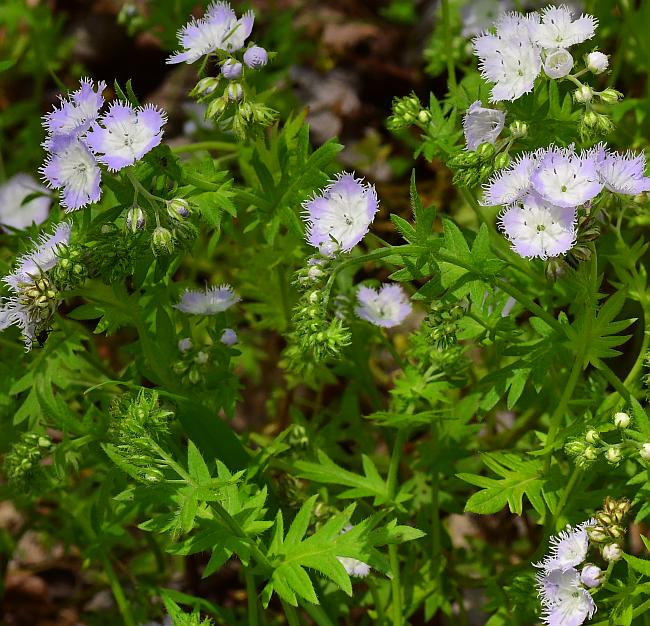Phacelia purshii Buckley
Miami Mist

Native
CC = 4
CW = 5
MOC = 25
© SRTurner
Phacelia purshii BuckleyMiami Mist | |
 |
Native CC = 4 CW = 5 MOC = 25 |
© SRTurner |
|
Family - Hydrophyllaceae Habit - Relatively slender annual forb, from a taproot. Stems - Ascending to erect, to 40 cm, unbranched or few-to several-branched at the base and above, mostly strongly ascending from a sometimes spreading base, moderately pubescent with stiff, appressed or antrorse, nonglandular hairs toward the base, sometimes also with moderate to dense, shorter, nonglandular hairs toward the tip, sometimes rooting at lower nodes.
Leaves - Alternate, petiolate below. Basal leaves usually withered at flowering, the blade 1-3 cm long, elliptic to oblong in outline, pinnately compound or deeply lobed with 3-7 pinnae or lobes, these entire or occasionally with 1 or 2 lobes or coarse teeth (the terminal leaflet or lobe usually 3-lobed), the leaflets or lobes sharply to bluntly pointed or occasionally rounded at the tips, the surfaces sparsely to moderately pubescent with antrorse, stiff hairs. Stem leaves short-petiolate to sessile and usually clasping, the blade 0.8-5.0 cm long, progressively reduced toward the stem tip, the uppermost leaf blades usually 5-9-lobed, the leaflets or lobes usually sharply pointed at the tips, the terminal lobe of at least the uppermost leaf truncate to somewhat angled or tapered at the base, the pubescence similar to that of the basal leaves.
Inflorescence - Scorpioid racemes with 8-30 flowers, terminating stems and lateral branches, the axis and flower stalks pubescent with dense, short, antrorse hairs, sometimes also with sparse, longer, stiff, spreading hairs, the stalks to 1.5 cm long in flower, ascending to spreading at fruiting.
Flowers - Calyces 3-7 mm long, the 5 lobes linear, with the margins and surfaces pubescent with longer and shorter hairs. Corollas 5-lobed, 5-8 mm long, broadly bell-shaped, pale lavender to light purple or bluish-tinged, often with a pale center, the margins coarsely and irregularly toothed to fringed, the outer surface glabrous or very sparsely hairy. Stamens usually somewhat exserted, the filaments 4-7 mm long, densely hairy below the midpoint. Ovary superior, green, conic, with an expanded nectariferous base, 1.2 mm long, with 4 ovules. Style shallowly to deeply branched, to 4 mm long, white, glabrous.
Fruits - Capsules 3-5 mm long, the surface not appearing swollen, mostly 2-4-seeded. Seeds 2-3 mm long, ovoid-angled, finely ridged and/or pitted, dark brown.
Flowering - April - June. Habitat - Bottomland and mesic forests, streambanks, bases and ledges of bluffs, prairies, glades, pastures, railroads, roadsides, and open disturbed areas. Origin - Native to the U.S. Lookalikes - P. gilioides, P. hirsuta. Other info. - This little species is found in Missouri mainly in eastern and southeastern counties, ranging eastward as far as Pennsylvania and Virginia. It is relatively easy to recognize by the pinnatifid leaves and fringed corolla lobes. The degree of fringing is somewhat variable, as is the corolla color, which ranges from lilac or bluish to nearly white. Another species, P. gilioides, can have minor fringing along the corolla lobes, but in that species the exterior of the corolla (the "back" of the flower) is finely hairy. Where it occurs, the plant can be quite abundant. Photographs taken at Big Spring State Park, Carter County, MO., 4-16-01 (DETenaglia); also along the along the Katy Trail near Augusta, St. Charles County, MO, 4-26-2011, along the Al Foster Trail near Glencoe, St. Louis County, MO, 4-8-2012, Young Conservation Area, Jefferson County, MO, 4-22-2015, along the Katy Trail near Treloar, Warren County, MO, 5-4-2020 and 4-22-2022, and Engelmann Woods Natural Area, Franklin County, MO, 4-28-2025 (SRTurner). |